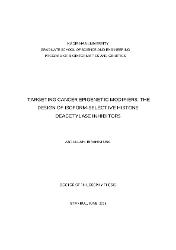| dc.contributor.advisor | Yelekçi, Kemal | en_US |
| dc.contributor.author | Uba, Abdullahi İbrahim | |
| dc.date.accessioned | 2019-07-12T08:30:06Z | en_US |
| dc.date.available | 2019-07-12T08:30:06Z | en_US |
| dc.date.issued | 2018 | en_US |
| dc.identifier.uri | https://hdl.handle.net/20.500.12469/1889 | |
| dc.description.abstract | Epigenetic alterations are believed to be the common hallmark of human cancers. Histone deacetylase (HDAC) inhibitors have proven to be effective in cancer cases where HDACs are up-regulated. However lack of selectivity of many of the HDAC inhibitors in clinical use and those at various stages of preclinical and clinical trials causes toxicity to the normal cells. it is believed that the continuous identification of isoform-selective HDAC inhibitors can eliminate this adverse effect — a task that remains particularly challenging due to the high sequence and structural conservations around the active site of HDAC isoforms. The original contribution of this study was analyzing the similarity among class i HDACs (1 2 3 and 8) and class iib HDACs (6 and 10) by sequence and structural alignments catalytic channel extraction and identification of catalytically essential amino acid residues. in addition homology model of human HDAC10 was built using a recently-released X-ray crystal structure of Danio rerio (zebrafish) HDAC10 as a template. Using these data isoform-selective HDAC inhibitors were designed by topology-based scaffold hopping structure- and ligand-based virtual screening. The top inhibitors (in terms of both binding affinity and selectivity) were subjected to structure-based in silico absorption distribution metabolism elimination and toxicity (ADMET) prediction which showed their druglikeness. Furthermore their docking complexes were submitted to molecular dynamics (MD) simulations to examine the stability of ligand binding modes. These potential isoform-selective HDAC inhibitors showed stable binding mode over time of the simulation. They can therefore serve as drug candidates or viable lead compounds for further modeling-based and experimental optimization towards the design of safe potent and selective HDAC inhibitors. | en_US |
| dc.description.abstract | Epigenetik değişiklikler insan kanserlerinin karakteristik bir özelliğidir. Histon
deasetilaz (HDAC) inhibitörlerinin, HDAC seviyesinin yükseldiği kanser vakalarında
etkili olduğu görülmüştür. Fakat, HDAC inhibitörlerinin izoformlar arasında seçici
olmaması, klinik olarak kullanımda olan, klinik ve pre-klinik denemelerde normal
hücreler üzerinde toksik etki göstermesine neden olmaktadır. HDAC izoformlarına
özgü inhibitör keşfinin bu yan etkileri gidereceğine inanılmaktadır. Ama bu keşif,
bilhassa HDAC izoformlarının yüksek sekans benzerliği ve aktif yüzeylerindeki yapısal
korunmuşluk yüzünden bir hayli zordur. Bu çalışmanın orijinal katkısı, sınıf I
HDAC’ların (HDAC 1, 2, 3 ve 8) ve sınıf IIb HDAC’ların (HDAC 6 ve 10) sekans ve
yapısal benzerliklerini, katalitik kanalın çözümlenmesini, ve kataliz için elzem amino
asitleri çalışmak oldu. Bunun yanı sıra, X-ray yapısı yeni yayınlanmış Danio rerio
(zebra balığı) HDAC10 proteinini kullanarak insan HDAC10 homoloji modeli inşa
edildi. Bu veriyi kullanarak, topoloji temelli iskelet sekmesi, yapı temelli ve ligand
temelli sanal tarama yöntemleriyle, izoforma özgü HDAC inhibitörleri dizayn ettim.
Bağlanma afinitesi ve seçicilik açısından en iyi inhibitör adayları, ilaç benzerlik
özelliklerini gösteren ADMET (in silico soğurma, dağılma, metabolizma, atılma ve
seçicilik) öngörü testine tabii tutuldu. Bunların kenetlenme (docking) kompleksleri,
ligand bağlanmasının stabilitesini ölçmek üzere, moleküler dinamik simülasyonlarına
sokuldu. Potansiyel HDAC izoformuna özgü inhibitör adayları, simülasyon boyunca
stabil bağlanma gösterdi. Bu sebepten ilaç adayı veya kuvvetli öncü moleküller
olabilirler; ilerde bu molekülleri modelleme yöntemleri veya deneysel optimizasyon
yöntemleri ile geliştirerek daha güvenli, kuvvetli, ve seçici HDAC inhibitörleri de elde
edilebilir. | en_US |
| dc.language.iso | eng | en_US |
| dc.publisher | Kadir Has Üniversitesi | en_US |
| dc.rights | info:eu-repo/semantics/openAccess | en_US |
| dc.subject | Epigenetic alterations in cancer | en_US |
| dc.subject | Homology modeling of human HDAC10 | en_US |
| dc.subject | Structure-based drug design | en_US |
| dc.subject | Structure-based ADMET prediction | en_US |
| dc.subject | Isoform-selective HDAC inhibitors | en_US |
| dc.subject | Kanserde epigenetik değişiklikler | en_US |
| dc.subject | İnsan HDAC10 proteininin homoloji modellemesi | en_US |
| dc.subject | Yapı temelli ilaç dizaynı | en_US |
| dc.subject | Yapı temelli ADMET öngörüsü | en_US |
| dc.subject | İzoforma özgü HDAC inhibitörleri | en_US |
| dc.title | Targeting cancer epigenetic modifiers: The design of isoform-selective histone deacetylase inhibitors | en_US |
| dc.type | doctoralThesis | en_US |
| dc.department | Enstitüler, Lisansüstü Eğitim Enstitüsü, Biyoinformatik ve Genetik Ana Bilim Dalı | en_US |
| dc.relation.publicationcategory | Tez | en_US |
| dc.identifier.yoktezid | 514422 | en_US |
















